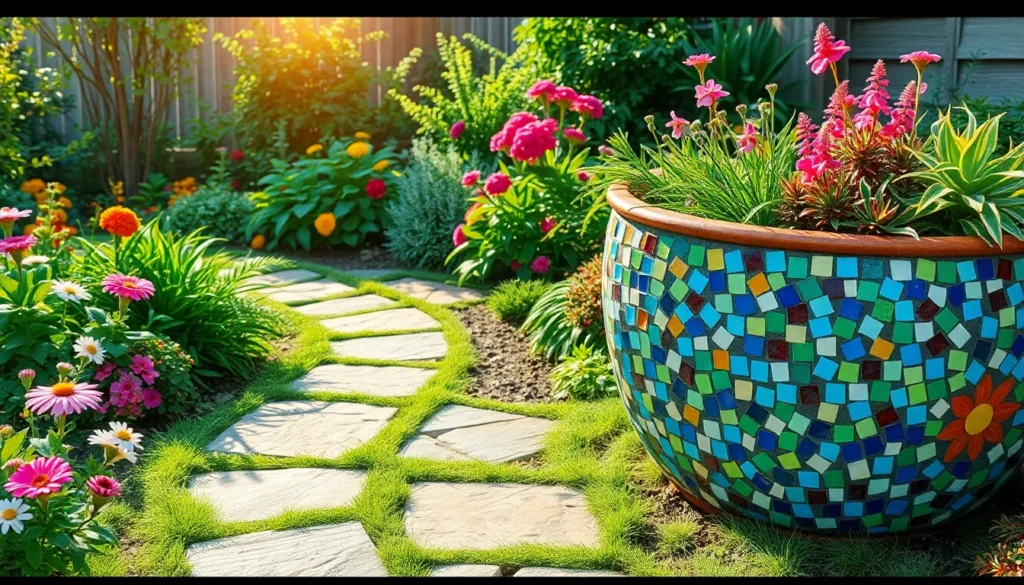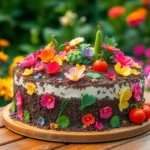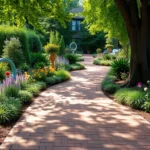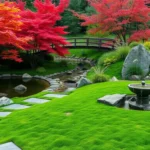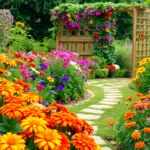We’ve all dreamed of transforming our outdoor spaces into stunning works of art, and garden mosaics offer the perfect solution to turn that vision into reality. These captivating decorative elements don’t just add visual appeal—they create focal points that reflect your personality while boosting your property’s value.
Whether you’re working with a sprawling backyard or a cozy patio, mosaic garden art adapts to any space and budget. From stepping stone pathways that guide visitors through your industry to vibrant wall murals that breathe life into blank surfaces, the possibilities are endless. We’ve discovered that even beginners can master basic mosaic techniques with the right guidance and materials.
What makes garden mosaics truly special is their durability and low maintenance requirements. Unlike other decorative elements that fade or deteriorate, quality mosaics withstand weather extremes while maintaining their beauty for decades. Let’s explore creative ideas that’ll transform your garden into an artistic masterpiece that neighbors will admire year-round.
Create Stunning Stepping Stone Mosaics for Your Garden Pathways
Stepping stone mosaics transform ordinary garden pathways into captivating artistic journeys that guide visitors through your outdoor sanctuary. We’ll explore essential techniques for creating durable, beautiful mosaic stepping stones that withstand years of foot traffic and weather exposure.
Choose Weather-Resistant Materials Like Ceramic and Glass
Ceramic tiles provide exceptional durability for outdoor mosaic stepping stones, withstanding freeze-thaw cycles and heavy foot traffic. Porcelain varieties resist water absorption better than standard ceramic, making them ideal for regions with harsh winters. We recommend selecting tiles rated for outdoor use with slip-resistant surfaces to ensure safety on wet pathways.
Tempered glass pieces create brilliant light-catching effects that sparkle throughout the day while maintaining structural integrity. Stained glass remnants from create stores offer vibrant color options at affordable prices. Tumbled glass edges eliminate sharp surfaces, creating safe walking areas for barefoot garden strolls.
Natural stone fragments like marble, granite, and slate blend seamlessly with garden environments while providing excellent weather resistance. Broken pottery shards (known as pique assiette) add cottage garden charm when collected from vintage dishes and planters. Mirror tiles reflect surrounding plants and sky, creating ever-changing visual interest that changes with lighting conditions.
Design Patterns That Complement Your Garden’s Theme
Geometric patterns using square and rectangular tiles suit modern garden designs with clean lines and structured plantings. Hexagonal arrangements echo honeycomb shapes found in nature while providing strong visual impact along straight pathways. Circular designs radiate outward from central focal points, drawing attention to garden features like fountains or specimen plants.
Organic flowing patterns mimic natural elements like water ripples, leaf veins, or flower petals for cottage and woodland garden themes. Spiral designs create movement that guides the eye along curved pathways through informal garden spaces. Random mosaic layouts using broken ceramic pieces produce artistic chaos that complements wildflower gardens and naturalistic landscapes.
Color coordination with existing garden elements ensures stepping stones enhance rather than compete with plantings. Cool blues and greens complement foliage and water features while warm oranges and reds echo flowering plants and autumn displays. Monochromatic schemes using various shades of single colors create sophisticated pathways that never clash with seasonal garden changes.
Install Properly for Long-Lasting Durability
Base preparation requires excavating 4-6 inches deep and creating level surfaces using compacted gravel and sand layers. Proper drainage prevents water accumulation that causes frost heaving and mosaic damage during winter months. We recommend installing industry fabric beneath gravel to prevent weed growth that could destabilize stepping stones over time.
Adhesive selection determines long-term mosaic stability, with exterior-grade thin-set mortar providing superior bonding for outdoor applications. Waterproof grout prevents moisture infiltration that leads to tile loosening and winter damage. Two-part epoxy adhesives work well for smaller projects but require faster installation due to shorter working times.
Sealing techniques protect finished mosaics from weather damage while maintaining their original appearance for years. Penetrating sealers allow moisture vapor transmission while blocking liquid water absorption. We apply annual sealer coats to maintain protection levels, focusing extra attention on grout lines where water typically penetrates first.
Spacing considerations between stepping stones accommodate natural walking strides while allowing proper drainage around each installation. Standard 18-24 inch center-to-center spacing works for most adults, with slight adjustments based on household members’ heights. Consistent spacing creates rhythm along pathways while irregular placement adds visual interest to meandering garden routes.
Transform Ordinary Planters Into Mosaic Masterpieces
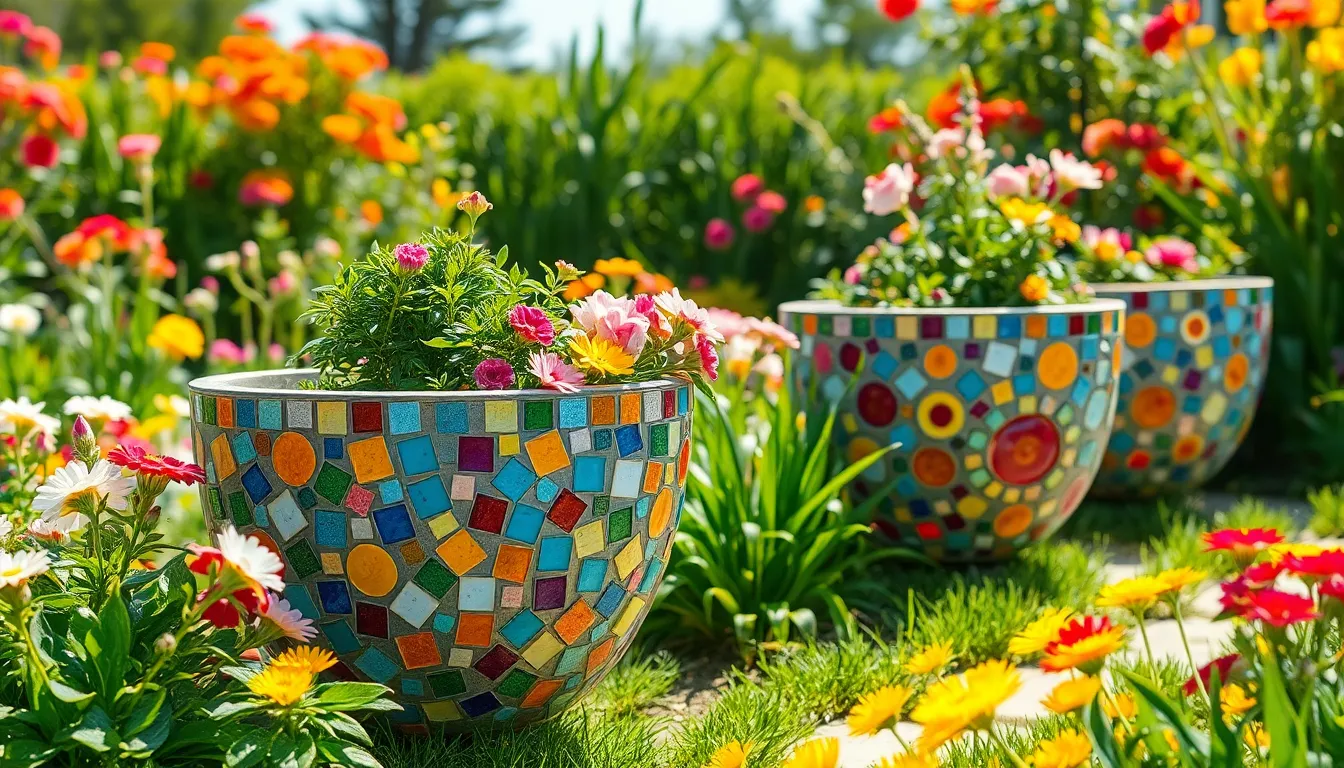
We can breathe new life into boring planters by covering them with stunning mosaic designs. Creating these artistic focal points adds personality to our garden spaces while showcasing our creativity.
Select Appropriate Base Materials for Outdoor Use
Glass tiles offer us the widest range of colors and create beautiful reflective surfaces that catch sunlight throughout the day. We’ll find these materials particularly effective for adding sparkle and dimension to our mosaic planters.
Marble pieces provide an elegant, natural appearance that blends seamlessly with garden surroundings. These durable stones withstand temperature fluctuations while maintaining their sophisticated look year after year.
Stone fragments deliver exceptional durability and earthy tones that complement outdoor environments perfectly. We can source these materials from various suppliers or even collect natural stones from beaches and riverbeds for unique textures.
Weather resistance becomes our top priority when selecting materials for outdoor mosaic projects. Materials must endure rain, frost, and UV exposure without cracking, fading, or deteriorating over multiple seasons.
Plan Color Schemes That Enhance Your Plants
Color harmony transforms ordinary planters into stunning garden features by complementing the natural hues of our plants. We should consider the dominant colors of our flowers, foliage, and stems when designing our mosaic patterns.
Seasonal plant changes require thoughtful color planning to ensure our mosaics remain visually appealing throughout the year. Green and blue tones work exceptionally well because they enhance both spring blooms and winter evergreens.
Contrasting accents help our plants pop against mosaic backgrounds while maintaining visual balance. We can use warm terracotta tones to highlight cool purple flowers or cool gray stones to make orange marigolds more vibrant.
Neutral base colors provide versatility when we’re uncertain about future plant selections. Cream, beige, and soft gray mosaics complement virtually any plant combination while allowing seasonal flowers to take center stage.
Apply Protective Sealers for Weather Protection
Water repellent sealers protect our mosaic investments from moisture damage that can cause tiles to loosen or crack during freeze thaw cycles. We must apply these protective coatings after grout has completely dried, typically waiting 48 hours for optimal results.
UV resistant formulas prevent color fading and material degradation from constant sun exposure. These specialized sealers maintain the vibrancy of our mosaic colors while protecting underlying adhesives from breaking down over time.
Application timing becomes critical for achieving maximum protection and longevity. We should plan sealer application during dry weather conditions with temperatures between 50°F and 80°F for proper curing.
Reapplication schedules ensure ongoing protection, with most quality sealers requiring renewal every 2 to 3 years depending on climate conditions. Regular maintenance keeps our mosaic planters looking fresh and prevents costly repairs from weather damage.
Design Eye-Catching Mosaic Garden Walls and Fences
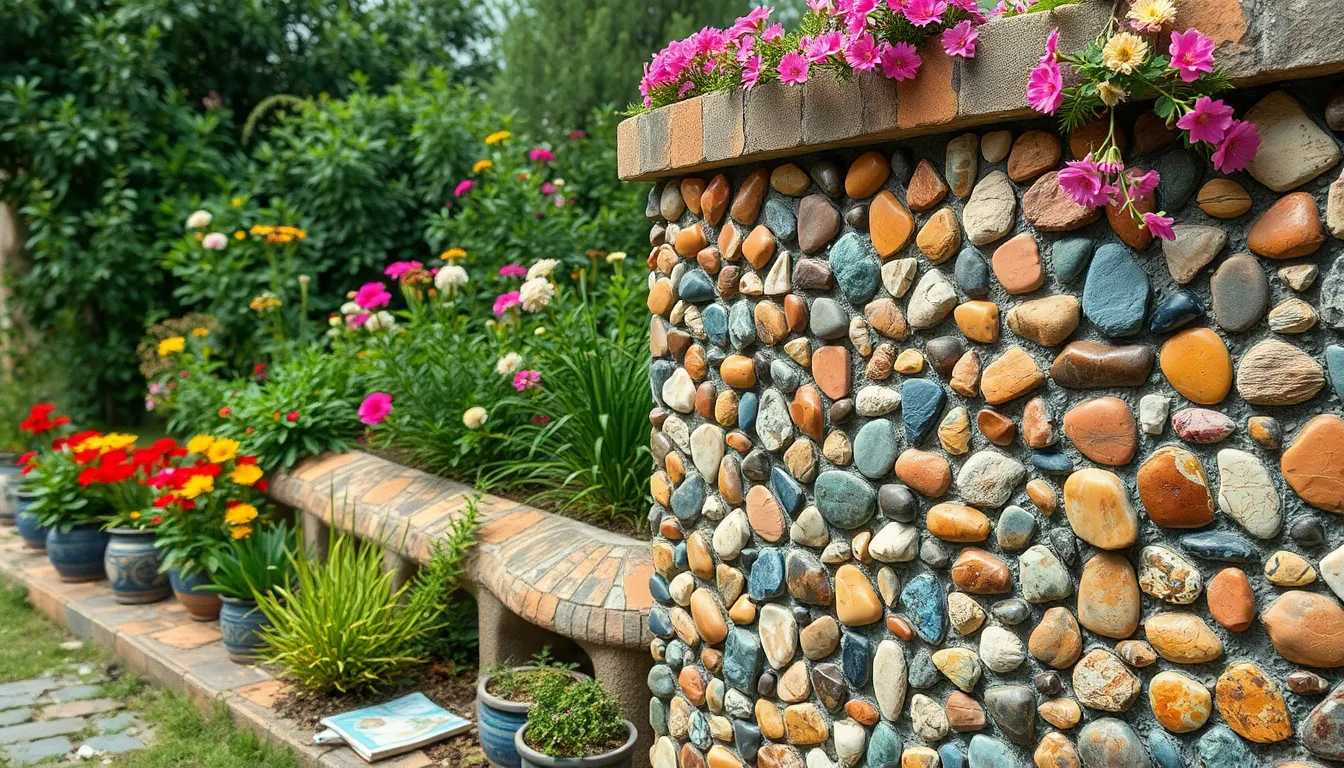
Transforming vertical surfaces into stunning mosaic displays creates dramatic backdrops that elevate your entire outdoor space. We’ll explore three essential strategies for designing captivating wall and fence mosaics that complement your garden’s natural beauty.
Incorporate Natural Stone and Broken Pottery
Natural elements bring authenticity and earthy charm to your mosaic designs when you blend them seamlessly with your garden environment. We recommend combining smooth river stones with fragments of weathered pottery to create textural contrasts that catch light throughout the day. Broken ceramic pieces from vintage plates or terra cotta pots add character while maintaining the organic feel essential for outdoor spaces.
Textural variety becomes your secret weapon when mixing rough natural stone with polished glass or ceramic elements. We’ve found that alternating between coarse limestone fragments and sleek marble chips creates depth that draws viewers closer to examine intricate details. Clay pottery shards work exceptionally well as transitional pieces between different stone textures.
Color harmony emerges naturally when you select stones and pottery that echo your existing industry palette. We suggest gathering materials that reflect the dominant colors in your soil, plants, and hardscaping features. Terra cotta fragments complement brick pathways while slate pieces enhance modern concrete elements.
Create Focal Points With Bold Pattern Combinations
Strategic pattern placement transforms ordinary walls into captivating artistic statements that command attention from multiple garden viewpoints. We design our most impactful mosaics by establishing one dominant pattern element then supporting it with complementary geometric or organic shapes. Large spiral motifs work beautifully as central features with smaller radiating patterns extending outward.
Contrasting colors amplify your pattern’s visual impact when you use them strategically to highlight exact design elements. We recommend selecting three primary colors then using the boldest shade sparingly as accent points within your pattern structure. Deep blues against warm terracotta create Mediterranean vibes while emerald greens with golden yellows evoke tropical settings.
Pattern repetition across longer fence sections maintains visual cohesion while allowing for creative variations that prevent monotony. We space identical motifs at regular intervals then fill connecting areas with flowing transition patterns. This approach works particularly well for privacy fences where consistent rhythm enhances the overall garden design.
Consider Scale and Proportion for Visual Impact
Proportional relationships between your mosaic elements and surrounding garden features determine whether your design enhances or overwhelms the space. We calculate tile sizes based on viewing distances, using larger pieces for walls viewed from across the garden and smaller detailed work for intimate seating areas. A 6-foot fence typically accommodates 4-inch square focal elements with 1-inch accent pieces.
Balance prevents visual chaos when you distribute large and small mosaic elements thoughtfully throughout your design composition. We anchor each section with substantial pieces then surround them with progressively smaller elements that create natural flow patterns. This technique mimics how nature distributes rocks and pebbles in creek beds.
Surrounding industry scale influences your mosaic proportions more than the wall dimensions themselves. We design bold, simplified patterns for gardens with large trees and expansive plantings while creating intricate detailed work for small courtyard spaces. Your mosaic should feel integrated rather than competing with existing garden elements for attention.
Build Beautiful Mosaic Water Features and Fountains
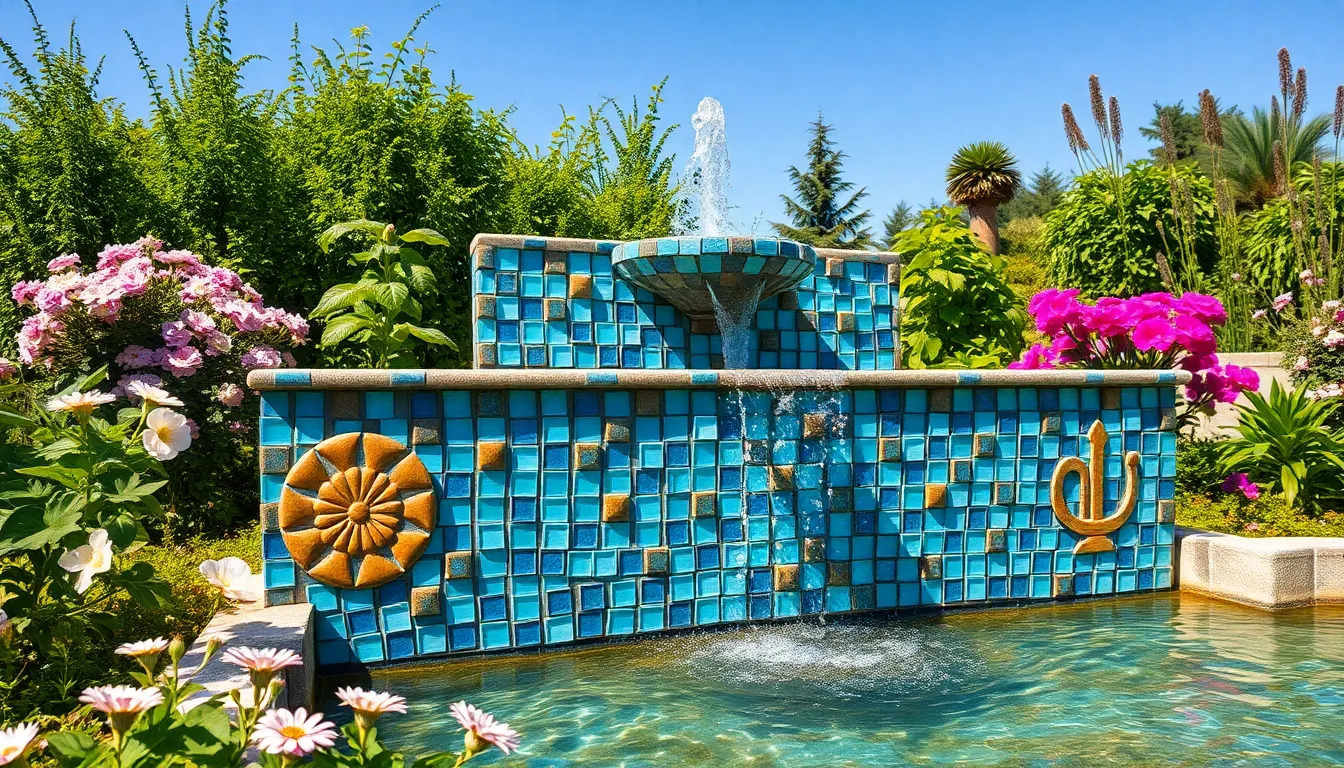
Water features elevate our garden mosaics from beautiful to breathtaking. We’ll guide you through the essential techniques for creating stunning mosaic fountains and water elements that combine artistic flair with lasting durability.
Use Waterproof Adhesives and Grout
Waterproof materials form the foundation of successful mosaic water features that withstand constant exposure to moisture. We recommend marine-grade epoxy adhesives specifically designed for underwater applications, as these products maintain their bond strength even when submerged. Traditional cement-based adhesives fail within months when exposed to continuous water flow, leading to tile displacement and costly repairs.
Selecting the right grout becomes equally critical for long-term success. Epoxy-based grouts resist water penetration while maintaining flexibility through temperature changes that cause expansion and contraction. We’ve found that silicone-modified grouts work exceptionally well for fountain applications where water pressure creates additional stress on mosaic joints.
Application timing affects the final result significantly. Apply adhesives and grout during dry weather conditions with temperatures between 60-80°F for optimal curing. This temperature range allows proper chemical bonding while preventing rapid moisture loss that creates weak spots in the installation.
Select Colors That Reflect Light Beautifully
Light reflection transforms ordinary mosaic water features into captivating focal points that sparkle throughout the day. We choose iridescent glass tiles and mirror fragments to maximize light play as water moves across the surface. Blues and aqua tones create natural water illusions while complementing the actual water element.
Metallic accents add sophisticated shimmer without overwhelming the overall design. Gold and copper tiles catch sunlight during peak hours, creating warm glows that enhance evening garden ambiance. We strategically place these reflective elements around water entry points where movement creates the most ever-changing light patterns.
Color gradation techniques enhance the illusion of water depth and movement. Start with darker blues at the bottom of fountains and transition to lighter aqua tones toward water level. This gradient effect mimics natural water bodies while creating visual depth that makes shallow features appear more substantial.
Maintain Proper Drainage and Water Flow
Drainage systems prevent water stagnation that leads to algae growth and unpleasant odors in mosaic water features. We install dedicated drainage outlets at the lowest points of each water feature to ensure complete water evacuation during maintenance periods. These drainage points also prevent ice damage during winter months in colder climates.
Water circulation keeps mosaic surfaces clean while preventing mineral buildup that dulls tile finishes. Submersible pumps sized appropriately for each feature volume maintain consistent flow rates that prevent debris accumulation in mosaic joints. We calculate pump capacity based on total water volume, desired flow rate, and vertical lift requirements.
Regular maintenance schedules preserve both water quality and mosaic appearance over time. Clean filters monthly and inspect grout lines quarterly for signs of deterioration or mineral deposits. These preventive measures extend the life of our mosaic water features while maintaining their original beauty and functionality.
Craft Decorative Mosaic Garden Furniture and Benches
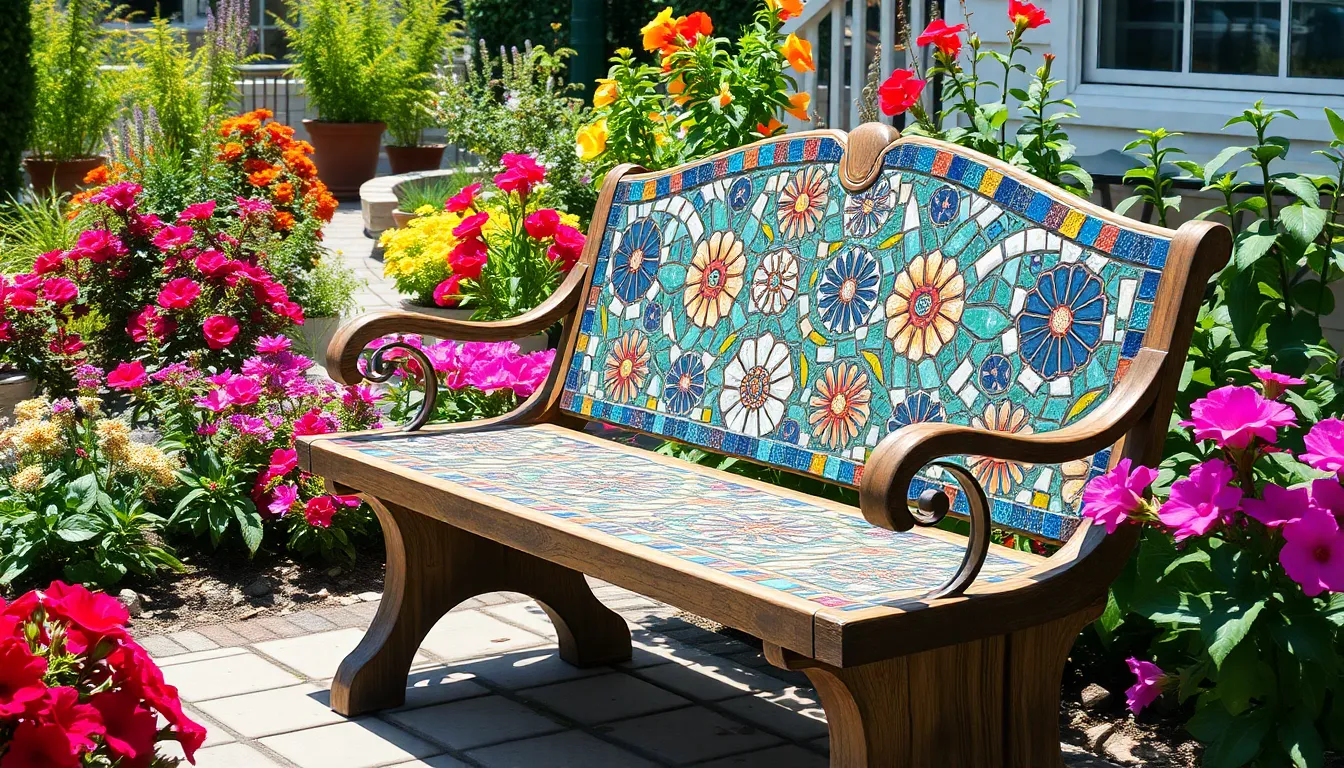
Creating beautiful mosaic furniture transforms ordinary outdoor seating into stunning focal points that combine functionality with artistic expression. These handcrafted pieces become conversation starters while providing comfortable gathering spaces for family and friends.
Choose Durable Outdoor Furniture Bases
Selecting the right foundation determines the longevity and stability of your mosaic furniture projects. We recommend starting with solid wood bases made from cedar, teak, or pressure-treated lumber that can withstand outdoor conditions for years. Metal frames constructed from powder-coated aluminum or stainless steel offer excellent durability and resist rust formation in humid environments.
Consider the weight capacity when choosing your base materials, as mosaic tiles add important mass to furniture pieces. Concrete forms provide exceptional stability for benches and tables, allowing you to create custom shapes that perfectly fit your garden’s design scheme. Stone bases like granite or marble slabs offer natural beauty and incredible durability, though they require more advanced installation techniques.
Pre-made outdoor furniture frames from garden centers or online retailers save time and ensure proper proportions for comfortable seating. Look for bases with smooth, non-porous surfaces that allow strong adhesive bonds with your chosen mosaic materials.
Plan Comfortable Seating Areas With Artistic Flair
Designing functional seating requires careful attention to ergonomics alongside aesthetic considerations. Standard bench heights range from 17 to 19 inches, while seat depths should measure 15 to 18 inches for optimal comfort during extended use. We suggest creating curved edges and rounded corners to prevent sharp contact points that could cause discomfort.
Incorporate design elements that reflect your garden’s overall theme, using glass tiles for contemporary spaces or natural stone fragments for rustic environments. Consider seasonal color schemes that complement your industry throughout the year, choosing cooler blues and greens for summer appeal or warmer earth tones for autumn harmony.
Plan your mosaic patterns to enhance the furniture’s function, using darker colors in high-wear areas where they’ll hide dirt and scratches more effectively. Create visual flow by connecting furniture pieces through repeated color patterns or complementary design motifs that tie your garden’s aesthetic together.
Position seating to take advantage of garden views, morning sun, or evening shade depending on your family’s outdoor living preferences. Leave adequate space between pieces for easy movement and conversation, typically 24 to 36 inches between furniture elements.
Protect Against Temperature Changes and Moisture
Weatherproofing ensures your mosaic furniture maintains its beauty through seasons of temperature fluctuations and moisture exposure. Apply high-quality outdoor sealants specifically designed for mosaic installations, focusing on penetrating sealers that protect both tiles and grout from water infiltration. We recommend marine-grade polyurethane or epoxy-based products that create flexible, waterproof barriers.
Temperature cycling causes expansion and contraction that can crack grout lines and loosen tiles over time. Use flexible grouts containing latex additives that accommodate movement without compromising the mosaic’s integrity. Silicon-based caulks work well for sealing edges where furniture meets vertical surfaces or joints that experience regular stress.
Schedule seasonal maintenance to inspect and touch up protective coatings, typically requiring reapplication every 2 to 3 years depending on climate conditions. Clean surfaces thoroughly before applying new sealant layers, removing any mildew, dirt, or degraded coating materials that could prevent proper adhesion.
Store removable mosaic pieces like cushions or decorative elements in protected areas during harsh weather periods. Cover larger furniture with breathable outdoor covers that prevent moisture accumulation while allowing air circulation to prevent mold and mildew formation.
Add Mosaic Accents to Garden Sculptures and Art Pieces
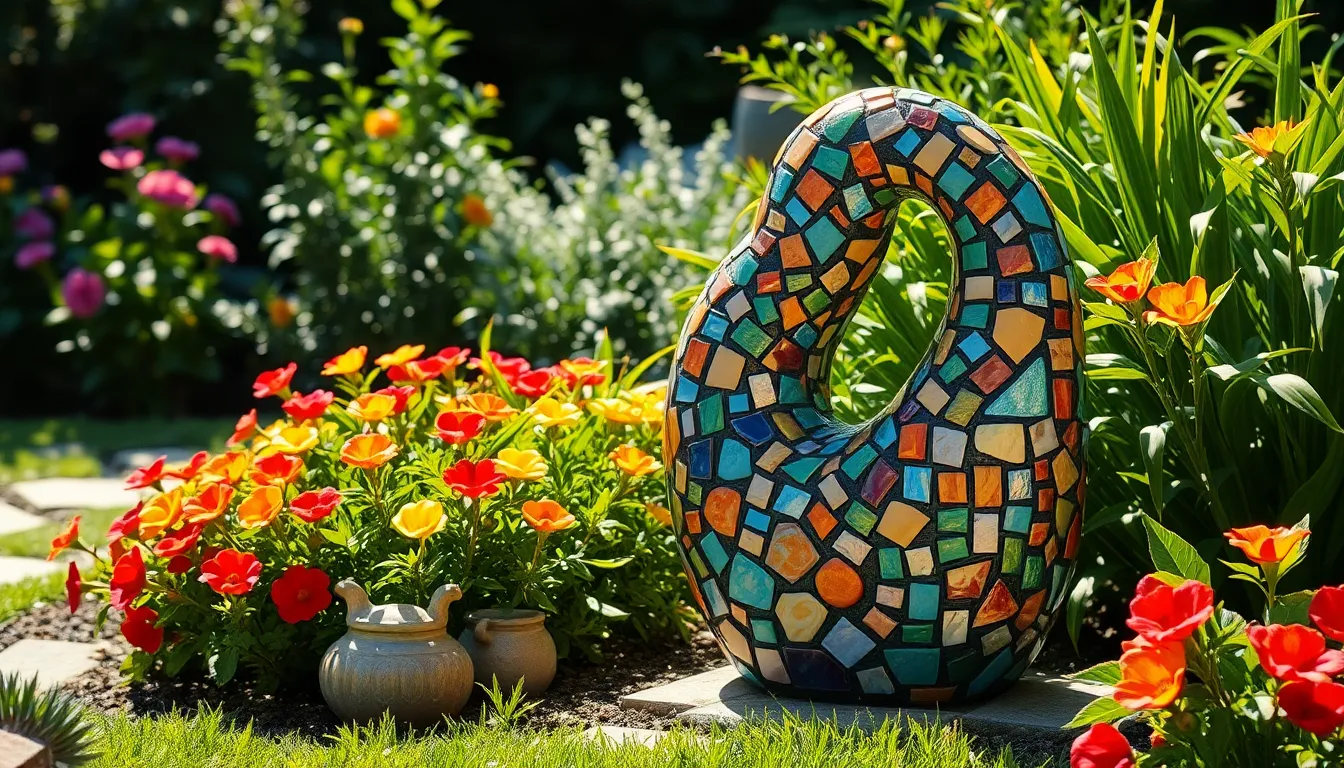
Garden sculptures and art pieces gain extraordinary character when we incorporate mosaic designs into their surfaces. Budget-friendly mosaic integration transforms ordinary garden features into captivating focal points that reflect our personal artistic vision.
Repurpose Old Items Into Stunning Garden Features
Creative recycling breathes new life into forgotten household items like glass bottles, ceramic dishes, and old tiles. We can transform these discarded materials into vibrant mosaic garden features that cost a fraction of commercial alternatives. Broken pottery pieces create authentic textures when we arrange them on fountain surfaces or planter exteriors.
Diverse materials like marble chips, glass fragments, stone pieces, and wood tiles offer unlimited design possibilities for our mosaic projects. Old mirrors provide reflective elements that catch sunlight and create dancing light patterns throughout our garden spaces. We’ll find that combining different material textures adds depth and visual interest to sculptures and art installations.
Simple tools like tile nippers, grout spreaders, and sponges make mosaic creation accessible to gardeners at any skill level. Household adhesives work well for smaller projects, while outdoor-rated materials ensure our creations withstand weather challenges.
Blend Mosaics With Natural Garden Elements
Nature-inspired mosaic themes create seamless integration between artificial art and organic garden beauty. We can design mosaics that depict flowers, leaves, butterflies, or insects to complement our existing plantings. These natural motifs help our mosaic sculptures feel like organic extensions of the garden industry.
Organic materials like river pebbles, natural stone fragments, and sea glass enhance our mosaic designs while maintaining harmony with surrounding vegetation. Combining these elements with traditional mosaic tiles creates unique textures that bridge the gap between crafted art and natural beauty. We often discover that incorporating actual plant materials like pressed leaves or flower petals adds authentic garden character to our pieces.
Earth-toned color palettes help our mosaic accents complement rather than compete with seasonal flower displays and foliage changes throughout the year.
Position Pieces for Maximum Visual Appeal
Strategic placement transforms mosaic-accented sculptures into powerful focal points that draw visitors through our garden spaces. We position larger pieces along main pathways where they’ll catch natural light and create visual anchors for garden rooms. Corner locations work well for sculptures that we want to discover gradually as guests explore our outdoor spaces.
Blue glass and marble tiles create elegant pathway markers that complement natural garden tones while providing subtle navigation cues. Wall-mounted mosaic pieces gain prominence when we install them at eye level near seating areas or gathering spaces. We’ve found that grouping smaller mosaic accents in odd numbers creates more ever-changing visual arrangements than symmetrical displays.
Fountain surroundings and pond edges offer ideal locations for mosaic sculptures because water reflections amplify the artistic impact of our creations. Garden benches and arbor supports become stunning features when we add mosaic accents that coordinate with nearby plantings and hardscape elements.
Install Mosaic Borders and Edging Around Garden Beds
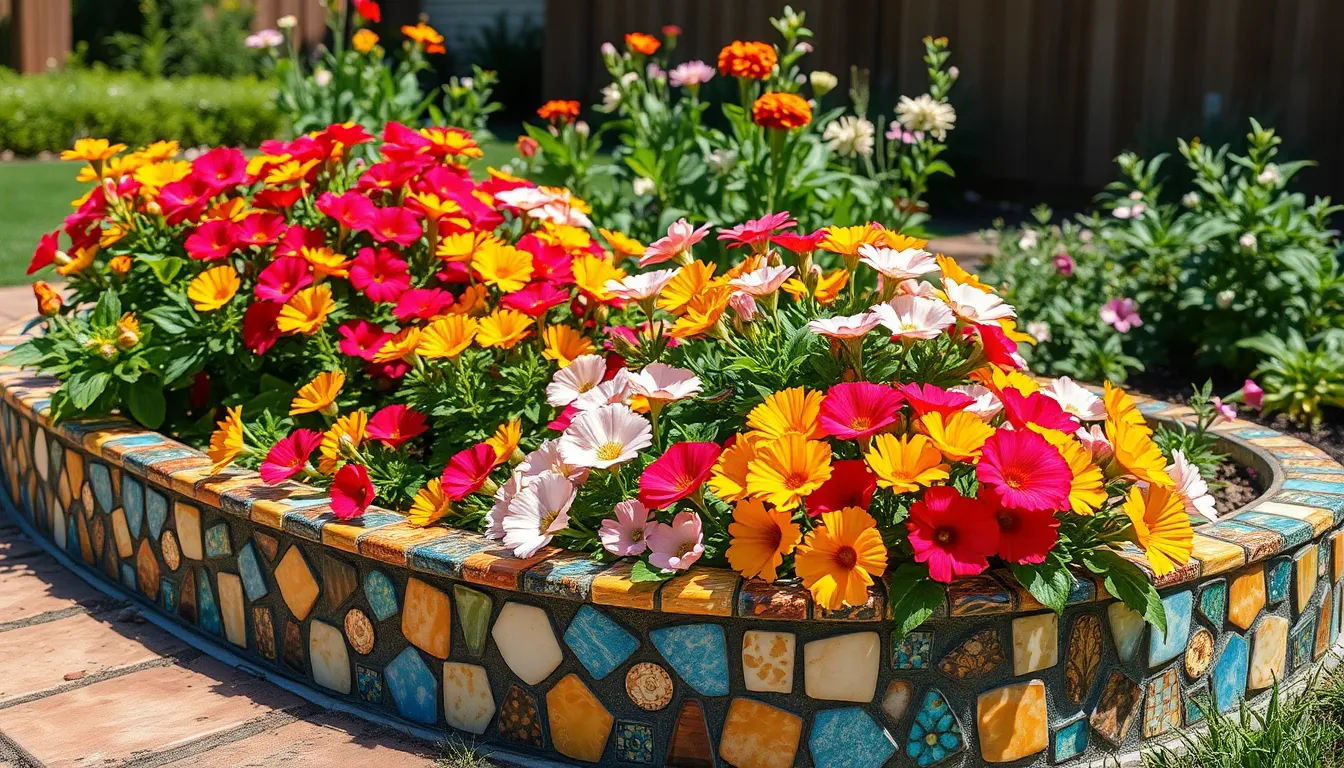
Creating beautiful mosaic borders around your garden beds transforms ordinary landscapes into artistic masterpieces. These decorative edgings serve as both functional boundaries and stunning visual elements that complement your existing garden design.
Define Garden Spaces With Colorful Patterns
Vibrant mosaic patterns help us create distinct zones within our gardens while adding personality to outdoor spaces. Blue glass and marble tiles work exceptionally well with the natural tones of plants, creating a harmonious balance between artificial and organic elements. We can incorporate themed mosaics like concentric circles or whimsical children’s play designs to add character and charm to different garden areas.
Botanical motifs using green and earth-tone tiles echo the surrounding vegetation while maintaining visual interest. Geometric patterns provide structure and modern appeal, especially when we use contrasting grout colors to emphasize the design. Seasonal color schemes allow us to adapt our mosaic borders throughout the year, incorporating warm oranges and reds for autumn themes or cool blues and whites for winter gardens.
Use Contrasting Colors for Clear Boundaries
Strategic color contrasts in our mosaic designs create crisp visual separations between different garden sections. Dark tiles against light backgrounds define pathways and planting areas with remarkable clarity, while bright accent colors draw attention to exact garden features. We should ensure that our chosen mosaic colors harmonize with surrounding vegetation to maintain overall cohesion in the industry design.
Neutral base colors like cream or gray provide versatile foundations that complement changing seasonal plantings. Bold accent strips using jewel tones create dramatic boundaries without overwhelming nearby plants. Color temperature plays a crucial role in boundary definition, with warm colors advancing visually and cool colors receding to create depth and dimension.
Ensure Proper Ground Preparation and Leveling
Thorough ground preparation forms the foundation for long-lasting mosaic installations that withstand weather and time. We must clear all debris, weeds, and loose soil from the installation area before beginning any mosaic work. Soil compaction prevents settling and shifting that could damage our carefully crafted borders over time.
Leveling the surface ensures even mosaic placement and prevents water accumulation that leads to frost damage. We can use both direct methods for on-site creation and indirect methods for pre-made sections, depending on our project scope and timeline. Proper drainage considerations prevent water from pooling beneath mosaic elements, extending the life of our installations significantly.
Base materials like sand or concrete provide stable foundations for different mosaic applications. Installation depth should account for frost lines in colder climates to prevent heaving and cracking during winter months.
Create Mosaic House Numbers and Garden Signs
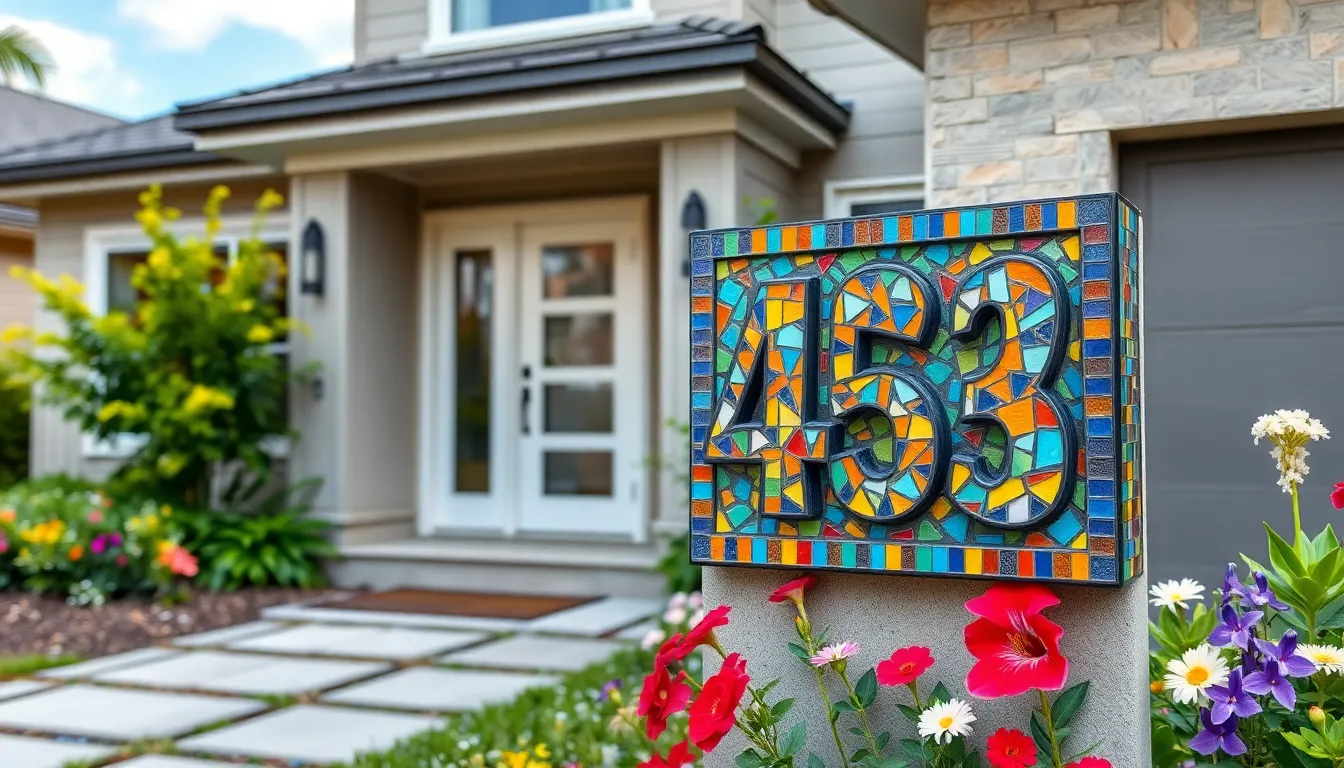
Mosaic house numbers and garden signs add functional artistry to our outdoor spaces while providing essential wayfinding elements. These personalized installations serve as welcoming features that reflect our unique style and enhance curb appeal.
Design Readable Numbers With Artistic Style
Bold, contrasting colors ensure our mosaic house numbers remain visible from the street while maintaining artistic appeal. We recommend using dark tiles against light backgrounds or light tiles against dark backgrounds to create maximum readability. High contrast combinations like navy blue against cream or charcoal against white work exceptionally well for visibility.
Large format numbers measuring at least 6 inches in height provide optimal readability for emergency services and visitors. We should incorporate materials like glass tiles that catch sunlight during the day and reflect artificial lighting at night. Simple geometric patterns around the numbers add visual interest without compromising legibility.
Spacing between individual numbers should equal half the number height to ensure clear distinction. We can enhance readability by using uniform tile sizes within each number while varying background patterns for artistic flair.
Weather-Proof Your Signage for Year-Round Display
Marine grade adhesives provide superior bonding strength for outdoor mosaic installations exposed to temperature fluctuations and moisture. We must select waterproof grouts that resist cracking and discoloration from UV exposure and freeze thaw cycles.
Sealed natural stone or ceramic tiles withstand harsh weather conditions better than porous materials that absorb moisture. We should apply penetrating sealers annually to protect grout lines and maintain vibrant colors throughout seasonal changes.
Proper substrate preparation includes using cement backer board or exterior grade plywood treated with waterproof membrane. We recommend installing drainage channels behind wall mounted signs to prevent water accumulation that could damage the mosaic over time.
Temperature resistant materials like glass tiles and porcelain maintain their integrity through extreme weather conditions without cracking or fading.
Integrate With Your Home’s Architectural Style
Contemporary homes benefit from clean lined mosaic designs using neutral colors like gray, white, and black with minimal decorative elements. We can incorporate geometric patterns that echo the home’s modern features while maintaining sophisticated simplicity.
Traditional architectural styles pair beautifully with warm earth tones and natural stone materials that complement brick or wood exteriors. Curved elements and organic patterns enhance the classic appeal of colonial or craftsman style homes.
Mediterranean and Spanish revival homes showcase vibrant blues, terracotta, and warm yellows that reflect their cultural heritage. We should select tile colors that harmonize with existing stucco colors and roofline materials.
Scale considerations ensure our mosaic signs complement rather than overwhelm the home’s proportions. Larger homes can accommodate bold, dramatic mosaic installations while smaller residences benefit from more subtle, refined designs that enhance without dominating the facade.
Conclusion
Garden mosaics offer endless possibilities to transform our outdoor spaces into personalized works of art. From stepping stones and planters to water features and functional signage we’ve explored how these versatile decorative elements can enhance every corner of our gardens.
The beauty of mosaic art lies in its accessibility – whether we’re beginners or experienced crafters we can create stunning pieces that reflect our unique style. With proper materials weatherproofing techniques and regular maintenance our mosaic installations will provide years of enjoyment while adding important value to our properties.
We encourage you to start small with a simple project like a decorative planter or garden sign then gradually expand your mosaic journey. Your garden will thank you for the artistic touch and personal flair that only handcrafted mosaics can provide.
Frequently Asked Questions
What are the main benefits of adding garden mosaics to outdoor spaces?
Garden mosaics add visual interest, serve as focal points that reflect personal style, and increase property value. They’re versatile and can be adapted to various spaces and budgets, from simple pathways to elaborate wall murals. Quality mosaics are also durable and low-maintenance, making them a long-lasting choice for outdoor decoration that enhances your garden’s aesthetic appeal.
Can beginners learn to create garden mosaics?
Yes, beginners can definitely learn basic mosaic techniques with proper guidance. The art form is accessible to various skill levels, and you can start with simple projects like stepping stones or small planters before moving to more complex installations. With practice and the right materials, anyone can create beautiful mosaic art for their garden.
What materials work best for outdoor mosaic projects?
Weather-resistant materials are essential for outdoor mosaics. Ceramic tiles, glass pieces, and natural stone fragments are excellent choices due to their durability. For water features, use marine-grade epoxy adhesives. Always select materials that can withstand temperature changes, moisture, and UV exposure to ensure your mosaics maintain their beauty over time.
How do I choose colors for my garden mosaic designs?
Consider your garden’s existing color palette and seasonal changes when selecting mosaic colors. Use neutral base colors for versatility, and choose hues that complement your plants’ aesthetics. For water features, select colors that reflect light beautifully, such as iridescent glass tiles. Bold contrasting colors work well for borders and edging to define garden spaces clearly.
What maintenance do garden mosaics require?
Quality garden mosaics are relatively low-maintenance. Apply protective sealers to safeguard against moisture and UV damage, with reapplication needed periodically. For water features, maintain regular cleaning schedules to preserve water quality and mosaic appearance. Check grout lines annually and clean surfaces as needed to maintain their visual appeal and structural integrity.
How do I ensure my mosaic installations are durable?
Proper installation is key to durability. Prepare a level base with adequate drainage, use weather-resistant adhesives and flexible grouts, and apply high-quality sealants. For stepping stones and pathways, ensure proper spacing and base preparation. Choose appropriate materials for your specific application, such as marine-grade products for water features and UV-resistant options for sun-exposed areas.
Can I create mosaic designs on existing garden furniture?
Yes, you can transform existing outdoor furniture into mosaic masterpieces by selecting durable bases like solid wood or metal frames. Plan patterns that enhance functionality while reflecting your garden’s theme. Use weatherproofing techniques including high-quality sealants and flexible grouts to protect against temperature changes and moisture for long-lasting beautiful results.
What’s the best way to incorporate mosaics into small garden spaces?
For smaller spaces, focus on strategic placement of mosaic accents like borders, edging, or decorative planters. Consider vertical elements such as wall mosaics or mosaic-enhanced garden signs. House numbers and small stepping stones can add artistic flair without overwhelming the space. Choose designs that complement your garden’s scale and architectural style for harmonious integration.

